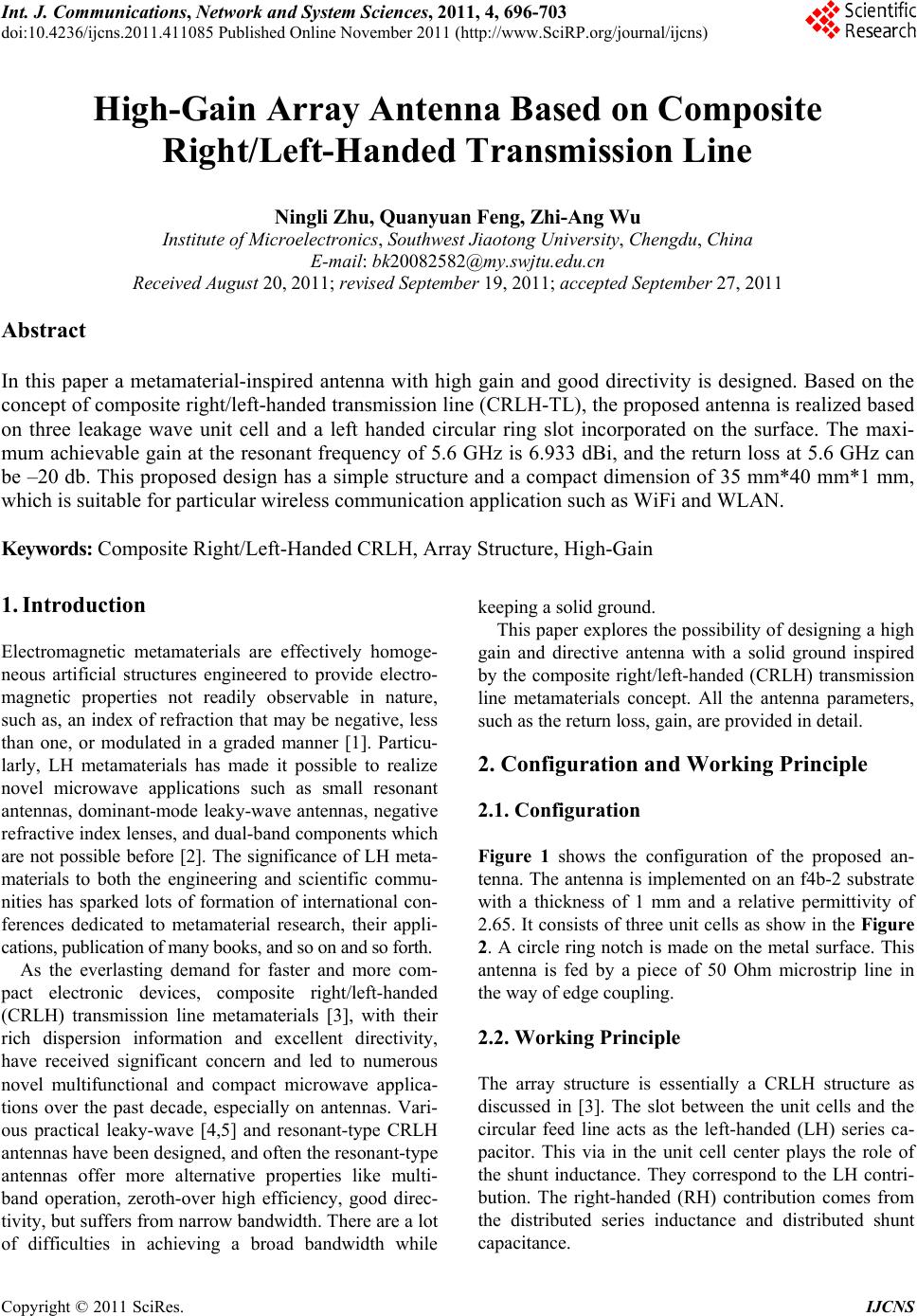
Int. J. Communications, Network and System Sciences, 2011, 4, 696-703
doi:10.4236/ijcns.2011.411085 Published Online November 2011 (http://www.SciRP.org/journal/ijcns)
Copyright © 2011 SciRes. IJCNS
High-Gain Array Antenna Based on Composite
Right/Left-Handed Transmission Line
Ningli Zhu, Quanyuan Feng, Zhi-Ang Wu
Institute of Microelectronics, Southwest Jiaotong University, Chengdu, China
E-mail: bk20082582@my.swjtu.edu.cn
Received August 20, 2011; revised September 19, 2011; accepted September 27, 2011
Abstract
In this paper a metamaterial-inspired antenna with high gain and good directivity is designed. Based on the
concept of composite right/left-handed transmission line (CRLH-TL), the proposed antenna is realized based
on three leakage wave unit cell and a left handed circular ring slot incorporated on the surface. The maxi-
mum achievable gain at the resonant frequency of 5.6 GHz is 6.933 dBi, and the return loss at 5.6 GHz can
be –20 db. This proposed design has a simple structure and a compact dimension of 35 mm*40 mm*1 mm,
which is suitable for particular wireless communication application such as WiFi and WLAN.
Keywords: Composite Right/Left-Handed CRLH, Array Structure, High-Gain
1. Introduction
Electromagnetic metamaterials are effectively homoge-
neous artificial structures engineered to provide electro-
magnetic properties not readily observable in nature,
such as, an index of refraction that may be negative, less
than one, or modulated in a graded manner [1]. Particu-
larly, LH metamaterials has made it possible to realize
novel microwave applications such as small resonant
antennas, dominant-mode leaky-wave antennas, negative
refractive index lenses, and dual-band components which
are not possible before [2]. The significance of LH meta-
materials to both the engineering and scientific commu-
nities has sparked lots of formation of international con-
ferences dedicated to metamaterial research, their appli-
cations, publication of many books, and so on and so forth.
As the everlasting demand for faster and more com-
pact electronic devices, composite right/left-handed
(CRLH) transmission line metamaterials [3], with their
rich dispersion information and excellent directivity,
have received significant concern and led to numerous
novel multifunctional and compact microwave applica-
tions over the past decade, especially on antennas. Vari-
ous practical leaky-wave [4,5] and resonant-type CRLH
antennas have been designed, and often the resonant-type
antennas offer more alternative properties like multi-
band operation, zeroth-over high efficiency, good direc-
tivity, but suffers from narrow bandwidth. There are a lot
of difficulties in achieving a broad bandwidth while
keeping a solid ground.
This paper explores the possibility of designing a high
gain and directive antenna with a solid ground inspired
by the composite right/left-handed (CRLH) transmission
line metamaterials concept. All the antenna parameters,
such as the return loss, gain, are provided in detail.
2. Configuration and Working Principle
2.1. Configuration
Figure 1 shows the configuration of the proposed an-
tenna. The antenna is implemented on an f4b-2 substrate
with a thickness of 1 mm and a relative permittivity of
2.65. It consists of three unit cells as show in the Figure
2. A circle ring notch is made on the metal surface. This
antenna is fed by a piece of 50 Ohm microstrip line in
the way of edge coupling.
2.2. Working Principle
The array structure is essentially a CRLH structure as
discussed in [3]. The slot between the unit cells and the
circular feed line acts as the left-handed (LH) series ca-
pacitor. This via in the unit cell center plays the role of
the shunt inductance. They correspond to the LH contri-
bution. The right-handed (RH) contribution comes from
the distributed series inductance and distributed shunt
capacitance.